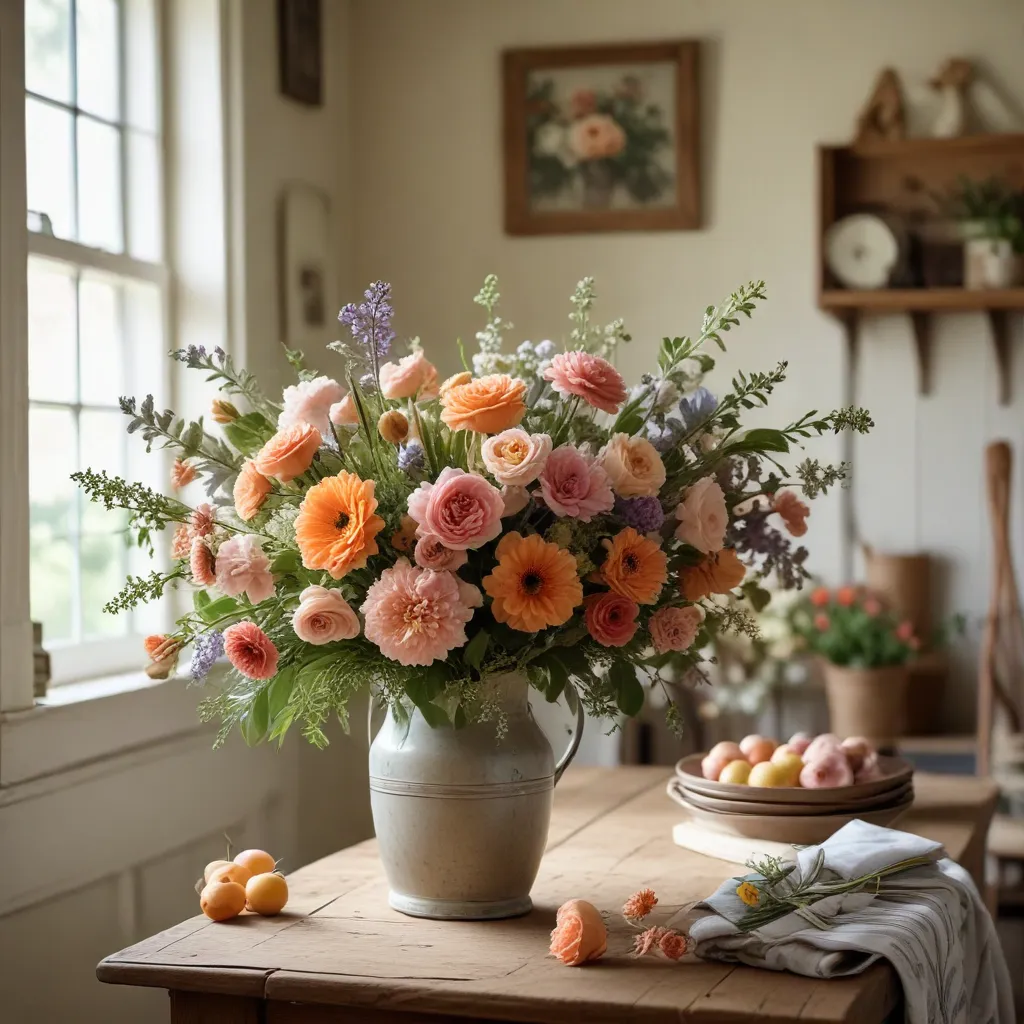
Farmhouse Florals: Growing and Arranging Stunning Cut Flowers
From the vibrant blooms carpeting our spring meadows to the bold bursts of color in our midsummer cutting gardens, the beauty of fresh-cut flowers has a way of capturing the essence of life on the farm. At Crooked Pines, we believe that cultivating and arranging stunning seasonal flowers is an art form that everyone can enjoy – whether you’re a seasoned gardener or just beginning to explore the joys of flower farming.
In this comprehensive guide, we’ll take you through the entire process of growing and arranging cut flowers, from preparing the soil to crafting breathtaking bouquets. Whether you’re looking to beautify your own home, delight your neighbors with thoughtful gifts, or even start a small flower business, this article will provide the insights and inspiration you need to make your farmhouse florals shine.
Flower Cultivation: Laying the Foundation
Successful cut flower growing starts with the soil. Before you even think about seeds or bulbs, take the time to assess your garden’s terrain and amend the earth as needed. A well-draining, nutrient-rich loamy soil is ideal – you can achieve this by mixing in generous amounts of compost and aged manure. Don’t forget to test your pH levels and adjust accordingly.
Next, choose your flower varieties carefully. While it’s tempting to pack your beds with every bright and beautiful blossom, focus on hardy annuals, perennials, and bulbs that are well-suited to your growing zone and have a long vase life. Some of our favorite cutting garden staples include zinnias, cosmos, sunflowers, dahlias, peonies, and fragrant sweet peas.
Once your soil is primed, it’s time to start sowing seeds and planting bulbs. Succession planting – sowing new batches of quick-growing annuals every 2-3 weeks – will keep your harvest bountiful from spring through fall. Don’t forget to trellis vining flowers like sweet peas and provide ample spacing for bushy, spreading plants.
Proper irrigation and nutrient management are also key. Flower beds should receive about 1 inch of water per week, either from rainfall or targeted watering. You can also give your plants a boost with liquid fertilizers or slow-release granules formulated for flowering crops.
Flower Varieties: Curating the Perfect Palette
With your growing foundation in place, it’s time to explore the vibrant world of cut flower varieties. From cheerful daffodils heralding spring’s arrival to the sumptuous blooms of dahlias in late summer, each season offers a unique floral bounty to celebrate.
For a quintessential farmhouse look, be sure to include plenty of old-fashioned heirloom varieties like sweet William, snapdragons, and celosia. These sturdy, long-lasting flowers will add charming texture and depth to your arrangements. Pair them with elegant garden roses, lisianthus, and anemones for a romantic, feminine feel.
Don’t forget about foliage – feathery Queen Anne’s lace, silvery dusty miller, and the lush green leaves of eucalyptus and Italian ruscus can all serve as beautiful supporting players. And for a pop of unexpected color, consider including burgundy or plum-hued blooms like scabiosa and chocolate cosmos.
Flower Arrangement Techniques: Crafting Farmhouse-Inspired Designs
With your freshly harvested flowers in hand, it’s time to let your creativity shine. Floral arranging may seem intimidating at first, but with a little practice, you’ll be crafting stunning bouquets worthy of the finest farmhouse aesthetic.
Start by considering color harmony – select a cohesive palette that evokes the rustic, natural beauty of the countryside. Pair soft pastels with rich jewel tones, or let a single bold hue take center stage. Arrange your flowers in a way that highlights their unique shapes and textures, using focal points and supporting elements to create visual interest.
When it comes to vases and containers, look no further than your own farmhouse. Repurpose vintage mason jars, antique pitchers, or weathered galvanized buckets for a charming, one-of-a-kind look. Don’t be afraid to mix and match vessels, either – a cluster of small bud vases can be just as striking as a single large arrangement.
Finally, remember to properly condition your flowers before arranging. Strip lower leaves, recut stems at an angle, and submerge the entire bouquet in clean water for at least an hour. This simple step will help ensure your floral creations maintain their freshness and vibrancy.
Floral Design Inspirations: Embracing the Farmhouse Aesthetic
With your newfound skills in flower cultivation and arrangement, the possibilities for stunning farmhouse florals are endless. Whether you’re dressing up your own home for a special occasion or creating bouquets to share with loved ones, let your creativity shine.
For a rustic, country-chic look, embrace natural textures and repurposed elements. Pair your freshly cut blooms with weathered wood, burlap, or even dried grasses for an effortlessly beautiful display. Arrange a cluster of small bud vases on a vintage tray, or tuck a single stem into a mason jar tied with twine.
As the seasons change, let your floral designs evolve. Celebrate the arrival of spring with a bounty of tulips, daffodils, and hyacinths, then shift to the lush, abundant blooms of summer – zinnias, sunflowers, and dahlias galore. And when autumn rolls around, warm hues of chrysanthemums, marigolds, and asters will add a cozy touch to your farmhouse décor.
Of course, floral arrangements also make wonderful gifts for birthdays, holidays, and other special occasions. Wrap a cheerful bouquet in kraft paper or burlap, finish with a rustic ribbon, and present it to a loved one for an extra-special touch. You can even create custom wedding or event florals that capture the essence of your farmhouse setting.
Whether you’re arranging flowers for your own home or sharing your creations with the world, the joy of cultivating and designing with nature’s bounty is a gift that keeps on giving. So grab your pruners, don your gardening gloves, and let your farmhouse florals shine!


